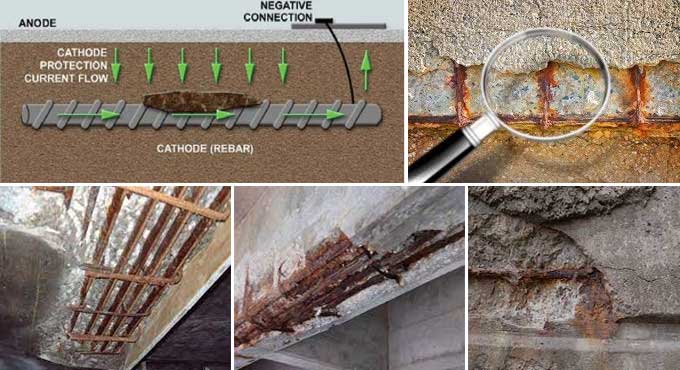NEWS | SOFTWARE | SHEET
What causes Rebar Corrosion in Concrete and how to prevent it?
Corrosion control is an integral part of concrete structure rehabilitation. Otherwise, the result is purely cosmetic and additional costly repair work is required within a few years.
During the oxidation process, a thin layer of oxide forms on the steel surface. Steel is protected from further corrosion by this oxide layer, which is stable in an alkali rich solution. When passive conditions are present, steel is unlikely to rust.
In the past, the space between reinforcement and concrete provided a passivation environment for reinforcement, which contributed to concrete cracking and corrosion by alkaline conditions.
What Causes Corrosion in Rebar?
Physical diffusion barriers against corrosion are also provided by well compacted concrete as well as adequate rebar covers, which reduce the penetration of atmospheric carbon dioxide, oxygen, and moisture.
Ingress of atmospheric carbon dioxide or sulfur dioxide can cause a reduction in alkalinity, as can the ingress of chloride ions or de-icing salts which may cause local breaching of passivation. Because of the high internal stresses of the rust, the concrete may eventually crack or even collapse due to the increased size of the rust on the rebar.
Corrosion Mechanism in Rebar
An oxide passivation layer forms over steel reinforcement in an alkaline concrete environment. The passivation layer can break down when salt, like sodium chloride or calcium chloride, is present in concrete.
In addition, steel's electrical potential will differ in concrete containing different salt concentrations, resulting in slightly different electrical potentials in different parts of the reinforcement cage. One rebar connects to another rebar through a flow of current. Corroding steel corrodes, but corrosion free steel remains un-corroded.
Anodic bars of steel with anodic corrosion and the rust that forms around them occupy a much larger volume than the original steel, causing the concrete around the bar to burst.
Cold Galvanization Method
The best protection is provided by a thin layer of cold galvanizing on reinforcing steel, which is extremely cost effective in comparison to other methods. Under any atmospheric condition, cold galvanizing is an easy to apply zinc coating that can be applied by brush, roller, spraying or dipping.
Compared to hot dip galvanizing, it provides better cathodic protection. The results of laboratory and field tests have been confirmed all around the world. There is 96 percent cathodic, active zinc in a cold Galva layer, which is pure to almost 100 percent.
- When rebar is bent and re-bent, the cold galvanized layer remains flexible and compressible. Rebar is handled roughly with a severe risk of damage, so this is surely an important aspect. The adhesion of the coating to concrete is good as well.
- Before contact with concrete, cold Galva may have a very short drying time. It is possible to pour concrete once the cold Galva is dry.
- The zinc salts will form on the surface of the concrete coating as soon as fresh concrete encapsulates the reinforcing steel covered by a cold galvanic layer. In addition to improving protection, they will completely seal off the cold Galva layer.
- Using cold galvanizing will protect concrete for more than a hundred years because it protects the rebar from corrosion.
To get more details, go through the following video tutorial.
Lecturer: Giatec Scientific Inc.
Define Cathodic Protection
An electrode is buried near the reinforcement in the concrete as part of the cathodic protection system. Cathodic protection has been gaining a lot of attention lately, since it has been shown to physically stop corrosion. An electrical current reverses the direction that steel rusts in concrete by cathodic protection.
It is connected to a direct current power source's positive terminal so that it acts as an anode since reinforcement is connected to the negative terminal. Positive current flows through the entire rebar cage when external power is adjusted. By doing so, corrosion currents no longer flow between previously anodic and cathode areas within the cage, stopping further corrosion.


